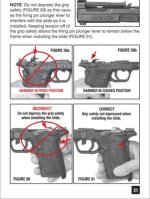YES.
Depressing the grip safety raises a bar in the left side of the frame that lifts the firing pin safety so that the firing pin is not blocked from forward movement.
Disabling the grip safety by tying or pining it down would be tantamount to removing the firing pin safety, which would obviously increase the gun's risk of firing if dropped. However, it would be a bit more complex, because the bar that the grip safety moves must be able to drop down (grip safety not depressed) for the slide to be removed or reinstalled (see page from manual below).
If the bar that is raised by the grip safety was removed, the condition of the grip safety would become irrelevant, but then there would be nothing to lift the firing pin safety. Thus, the firing pin safety would also have to be removed to be able to fire the gun. And removing the firing pin safety would be an obvious no-no.
This is a great explanation! I wanted to throw in my two cents after spending some time recently learning about the safeties and their operation.
I have the 380 EZ with thumb safety, which adds another layer to the pie. With the thumb safety off (which I assume causes the gun to mimic the non-thumb-safety model), the grip safety moves two pieces upward. The first is the lever which disengages the firing pin safety, which is on the left side as I look from the rear of the firearm. The second is a small piece which is attached to the trigger bar, which, when raised, aligns the trigger bar with the sear. If that piece is not raised, the trigger/trigger bar assembly can be moved rearward, but will not contact the sear.
The thumb safety on my 380 EZ appears to block the upward motion of that small piece, thereby keeping the trigger bar unaligned with the sear. So, with the grip safety depressed and the thumb safety on, the firing pin safety is disengaged but the trigger bar is not allowed to align with the sear.
In this way - thumb safety on, grip safety depressed - a measure of drop safety is, in my mind, still retained, since the trigger can move rearward without firing a round (trigger bar will not contact sear). However, since the depressed grip safety disengages the firing pin safety, any inadvertent disengagement of the sear and hammer would fire a round. I don't know if dropping a gun induces any measure of risk of hammer/sear disengagement, but if it does, you're not drop safe.
Open to any and all corrections on my understanding of how these safeties work! I'm used to getting way in the weeds on how things work together.
On a separate note, for those without thumb safeties: if the firearm was dropped, say onto the corner of a sidewalk, directly onto the grip safety... could it possibly fire?

